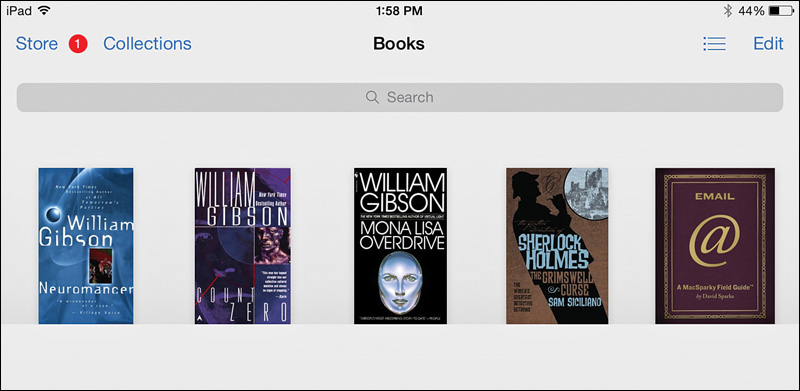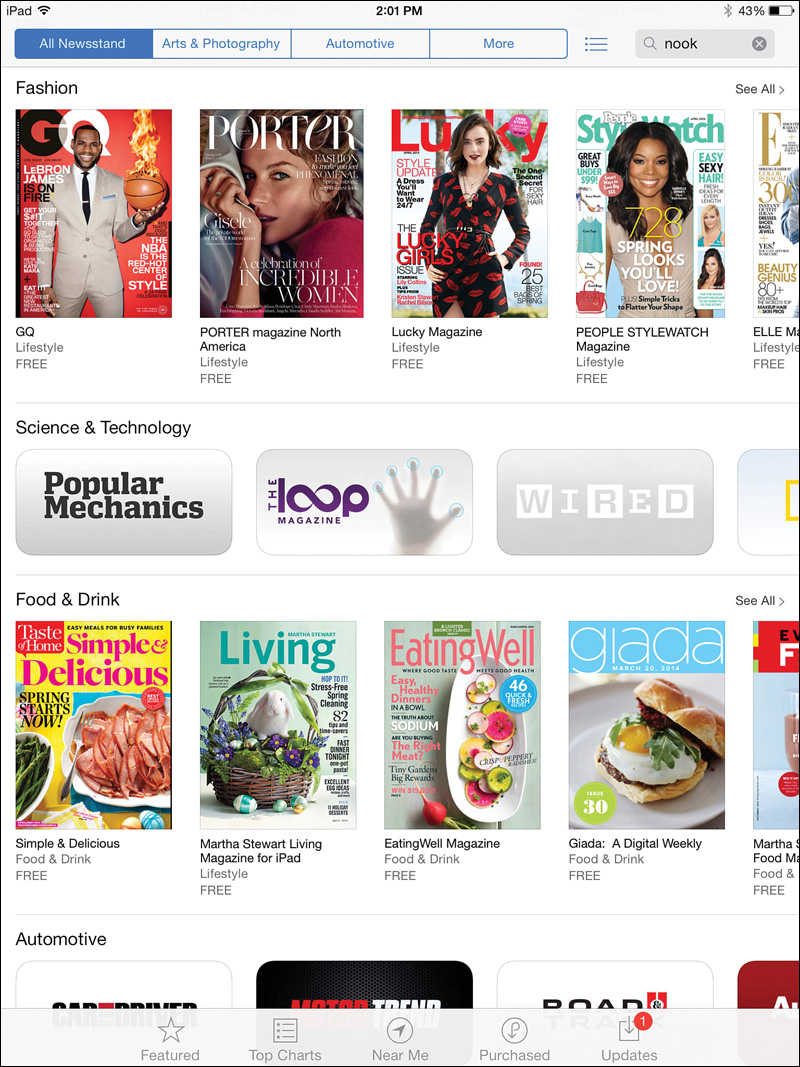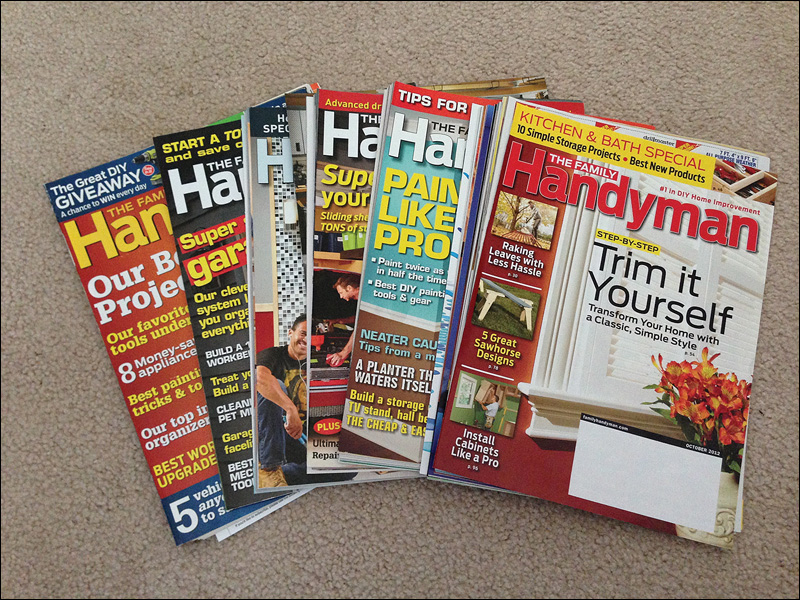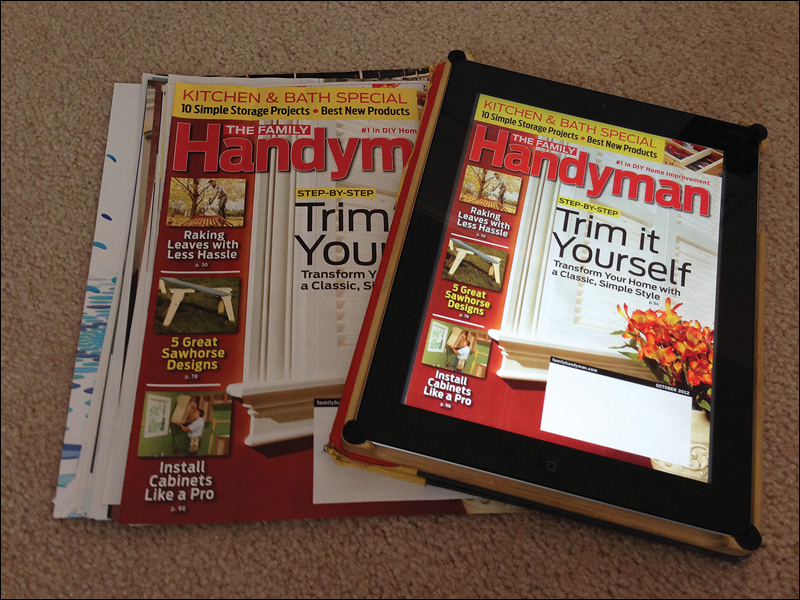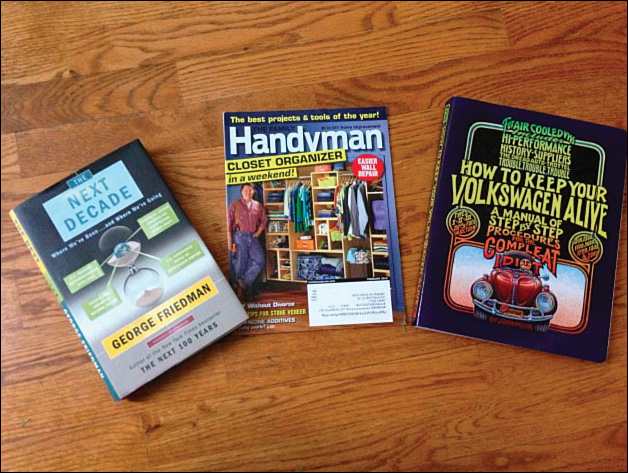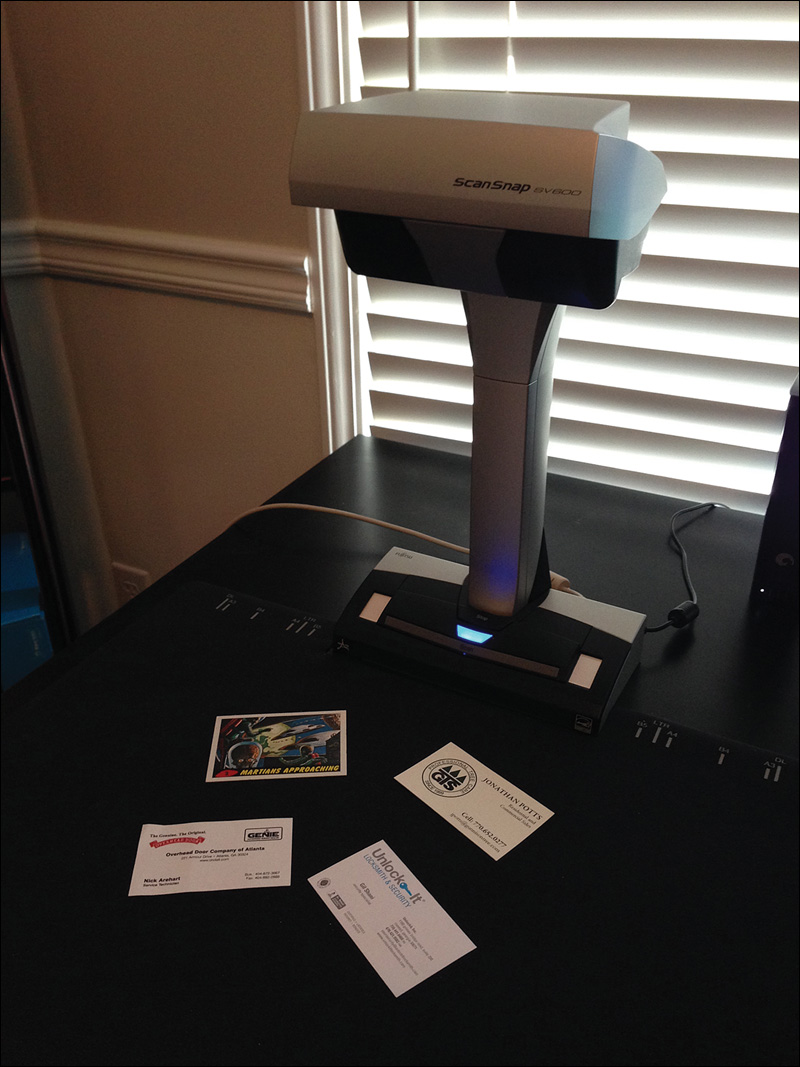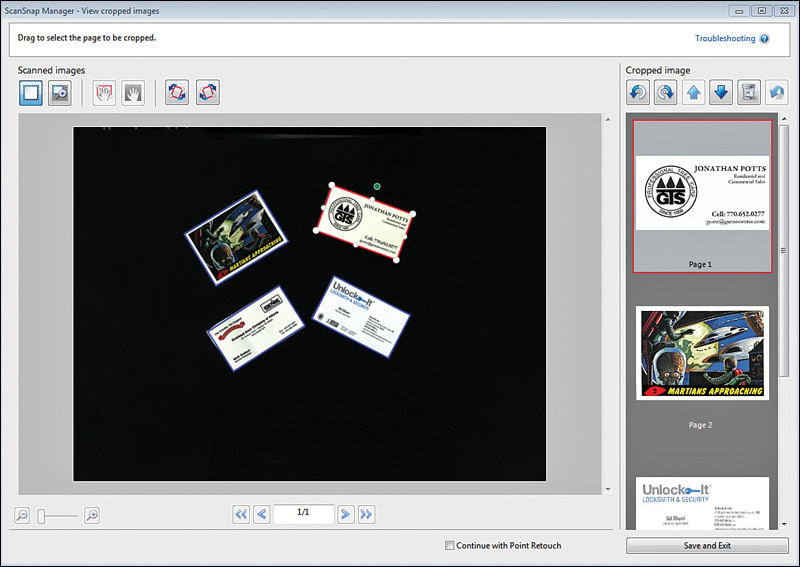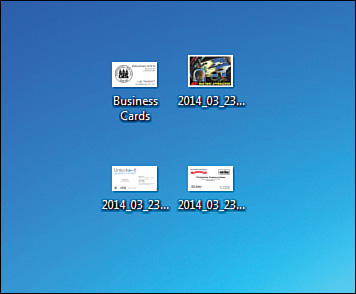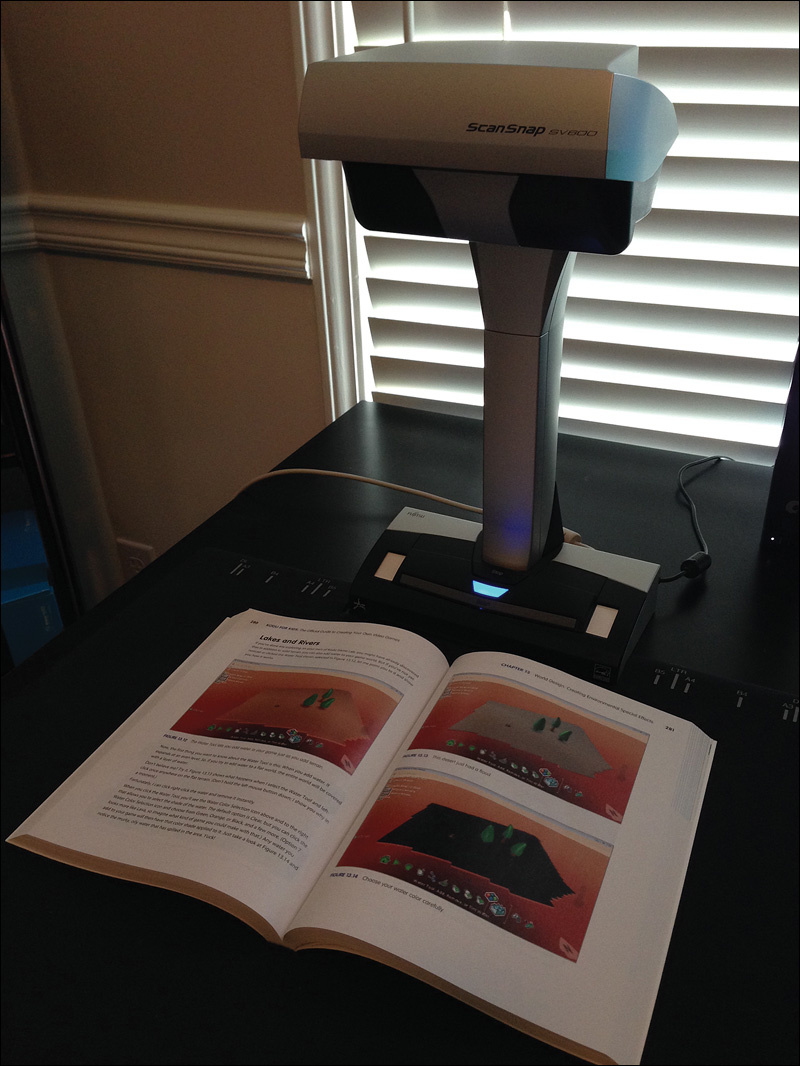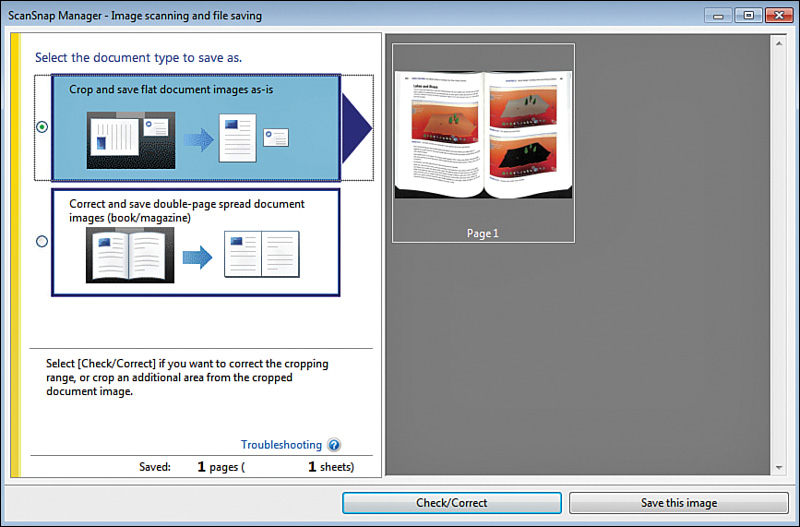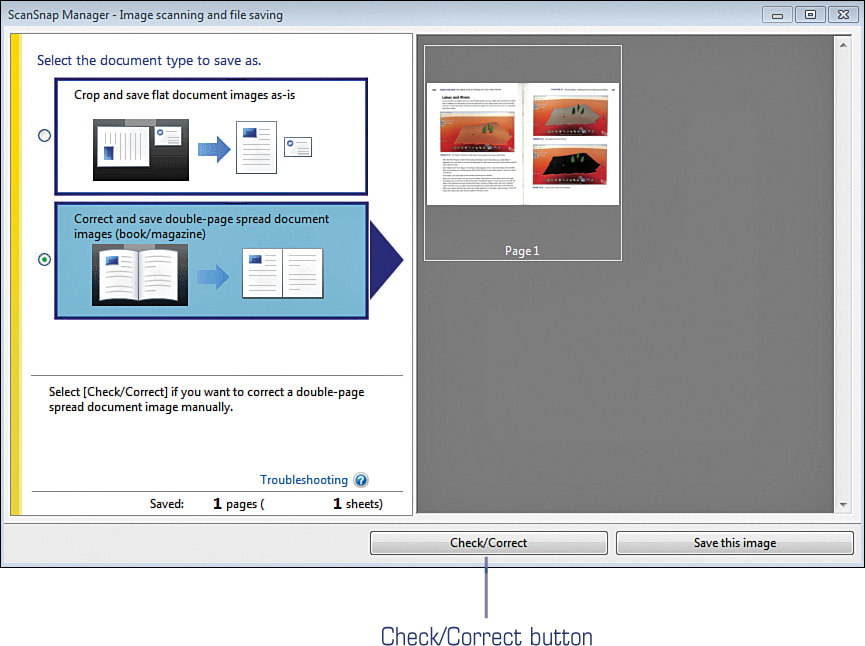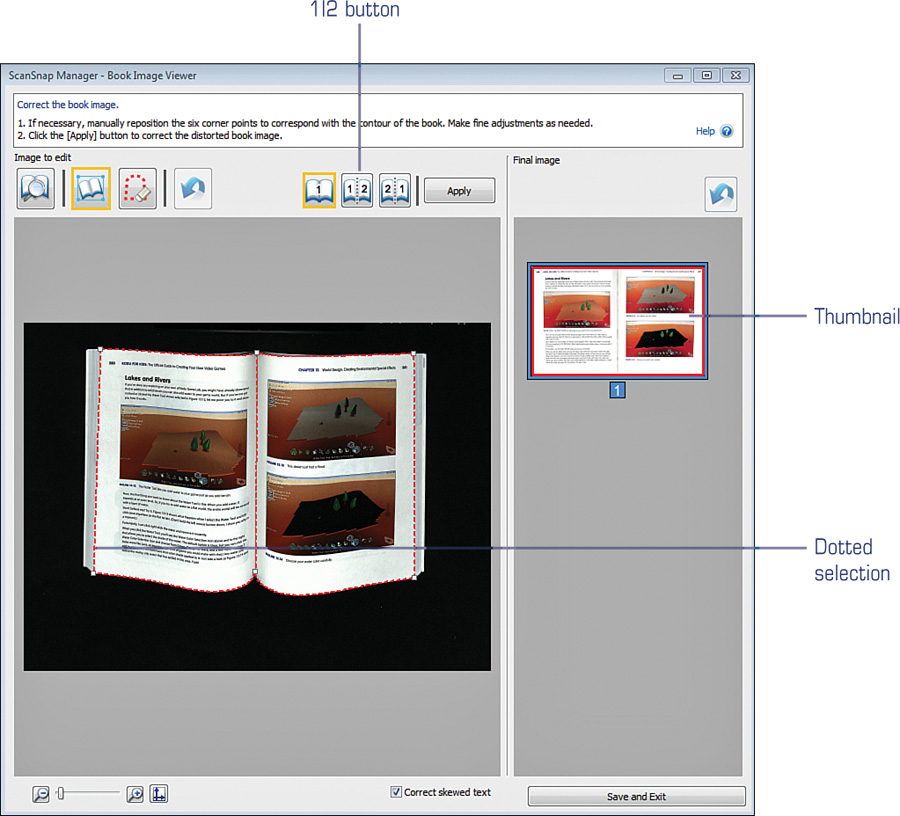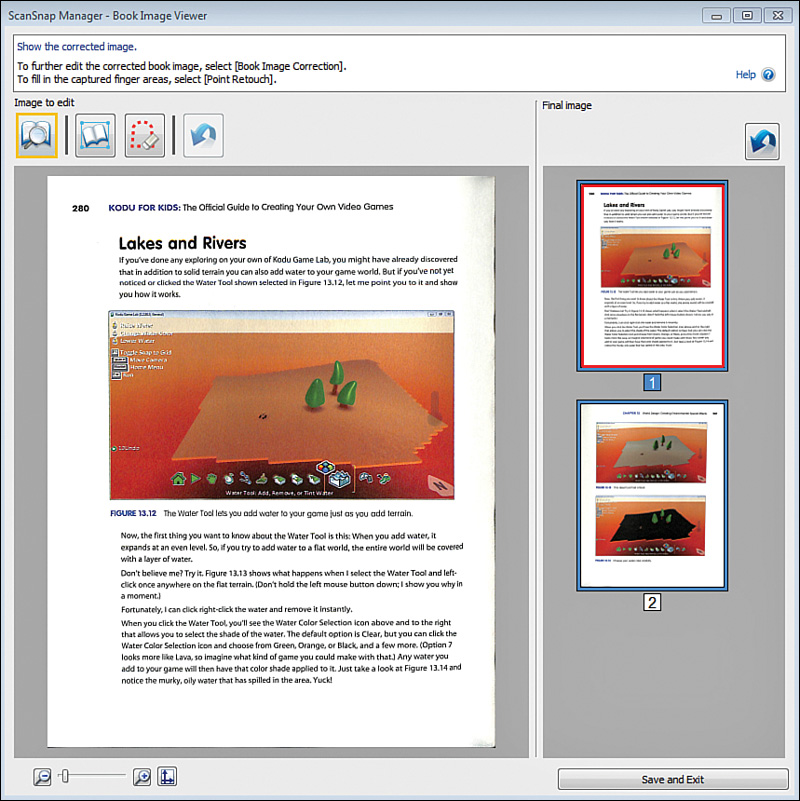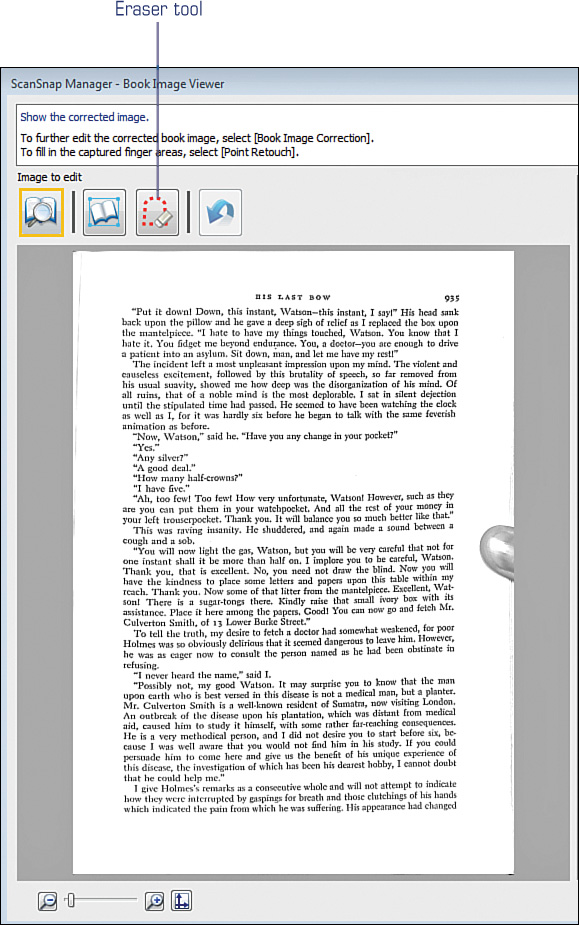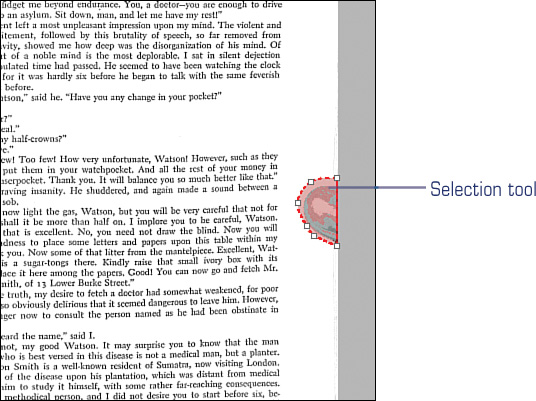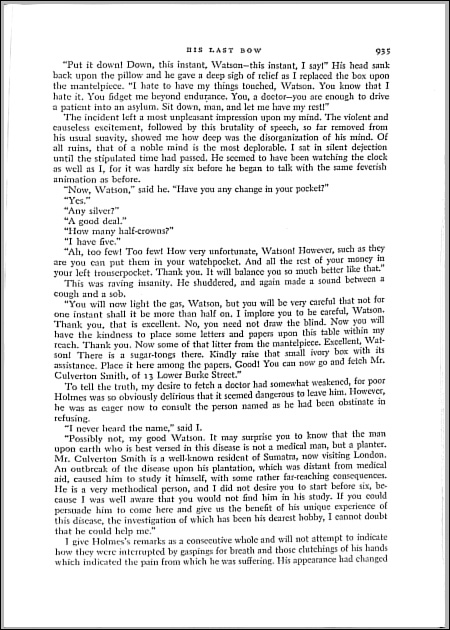7. Convert Your Collections: Reducing Book and Magazine Clutter
In This Chapter
![]() Buy digital books and subscribe to digital magazines
Buy digital books and subscribe to digital magazines
![]() Use the (slow-but-works) Cut-and-Scan method
Use the (slow-but-works) Cut-and-Scan method
![]() Use a book/magazine scanning service
Use a book/magazine scanning service
![]() Use a specialized book/magazine scanner
Use a specialized book/magazine scanner
![]() Risks of converting paper to digital
Risks of converting paper to digital
One of the most common requests I get from friends and family about my Ultimate iPad has to do with all the books and magazines that I have available from my Dropbox and Pogoplug accounts. I’ve been a book collector for decades (especially reference books) and I’ve subscribed to half a dozen magazines over the years that I keep for reference (many of these are related to my woodworking hobby). As you can imagine, after a certain point the space requirements began to be too much and I was forced to put a lot of my collection in a storage unit. The annoyance with not keeping my books and magazines on a bookshelf and instead tucked away in protective boxes comes when it’s time to retrieve one in storage.
I knew there had to be a better way, but it wasn’t until I started using the iPad that I realized the tablet could hold a substantially large amount of books and magazines in digital form. And even if my iPad ran of out of storage space, it would be a simple manner to transfer these digital files back and forth between either Dropbox or my Pogoplug-connected hard drive. I began to think how enjoyable it might be if I had a digital copy of every book and magazine I owned...and then I began to look for solutions.
Any solution (or solutions) I might find would need to allow for the fact that I already owned a lot of nondigital books and magazines. I had no desire to re-buy these items in digital format if they were even available, and in many cases some of the older books (such as my engineering textbooks from years ago) were no longer available in print or digital! And even if a book was available in digital format, I buy a lot of reference books on sale in the bargain bins—frequently I could buy a print version of a book cheaper than the digital version. My solution(s) would also need to make certain that my digital books and magazines would be searchable with keywords to make finding what I need fast and easy.
Solutions were found, and the chapter you’re about to read is going to show you all of the various methods that I’ve used over the last few years to convert about 80% of my book and magazine collection to digital files (the remaining 20% are books that I want to keep in print form for one reason or another). These converted books and magazines don’t exist in any proprietary format such as ePUB or Mobi—I save it all as searchable PDF files so I can read any book or magazine I own with the GoodReader app or even directly from Dropbox or Pogoplug. (I frequent the GoodReader app covered in Chapter 1, “The Ultimate iPad,” so I can add notes, highlight text, and perform other unique tasks.)
One of the goals of the Ultimate iPad is to make all your data available to you when you need it. This should include your books and magazines. Keep reading to learn about three different methods for bringing your entire book and magazine collection with you wherever you may travel.
Start with Digital Books and Magazines Now
If you’re truly wanting to lose the book and magazine stacks and push your iPad closer to Ultimate iPad status, one of the easiest solutions to implement immediately is to simply start buying your books in digital format from the beginning (if they are available as ebooks). The same goes for magazines.
If you’ve purchased ebooks from either Apple, Amazon.com, or BarnesandNoble.com, you may already be aware that apps are available for the iPad that allow you to read your digital purchases on your iPad. Figure 7.1 shows these three apps (iBooks, Nook, Kindle, respectively) installed on my iPad.
Purchases from Apple’s bookstore are opened in the iBooks app, purchases from Amazon are read on the Kindle app, and Barnes & Noble purchases can be read using the Nook app. (You may run into the occasional need to download a special reader of some sort; the Bluefire Reader shown in Figure 7.1 is one of those apps that I rarely use, but I do have some digital books that will only open with that app.)
All three of the aforementioned apps will display your books on a virtual bookshelf with miniature versions of the covers to help you find a particular title. Figure 7.2 shows the iBooks bookshelf with a handful of digital books.
Magazines are also enjoying a growth in popularity when it comes to their digital versions, called “ezines.” When it comes to the iPad, there are numerous options for subscribing to ezines, and three popular ones are Zinio, NextIssue, and Apple’s own Newsstand. Each of these installs an app on your iPad so you can access both paid and free periodicals. Browse for magazines, as shown in Figure 7.3, and tap a cover to purchase a single issue or subscribe.
Note
Be aware that some magazines are only available by subscribing and not as single-issue purchases. Also, some digital subscriptions come free with a paid print subscription—if you have a subscription to a print magazine, check to see if digital copies of those issues you’ve received are still available for download.
Users of apps for accessing digital books and magazines often have a lot of questions related to digital books and magazines. Is it better to buy ebooks from Amazon or Barnes & Noble? Should I subscribe to magazines using the Newsstand app or maybe Zinio? What happens if an app or company goes out of business—will I still have access to my books/magazines?
These are all good questions, and unfortunately there’s not very many good answers. Many digital book buyers will simply stick to the app they’ve used from the beginning and buy books from that source; others will buy an ebook from whichever source is selling it for the lowest price. And other ebook/ezine readers will only buy digital content if it’s available as a downloadable file that can be backed up in case a company goes out of business or an app is no longer available for a future tablet purchase.
In my case, I try to always buy ebooks as PDF files first, followed by ePub files next, and then Mobi if one of the previous two formats isn’t available. If I want a PDF file, this often means buying an ebook directly from the author (if the author has a website that offers PDF-formatted books for sale) so that I have a file that can be saved to Dropbox or my Pogoplug hard drive and will always be available to me if I have an app that can open PDF documents.
Caution
There are methods available for backing up books that are purchased from sites such as BarnesandNoble.com (for the Nook app) and Amazon.com (for the Kindle app), but what you’re backing up are files that are typically formatted for the specific app and won’t work with any other app. What this means is that if you choose to use a different app to read your ebooks, you may find that some ebooks won’t open or are not the correct format. It’s a true buyer beware situation.
Unfortunately, most ebooks these days don’t come in PDF format, and many ebooks are formatted or saved in such a way that they’ll only work with one particular app. Because of this, ebooks you buy from Amazon.com can only be read on your iPad with the Kindle app. The same goes for ebooks purchased from BarnesandNoble.com—those ebooks will require the Nook app. And you may find yourself purchasing an ebook directly from an author or website that requires a completely different app reader. It’s a mess out there when it comes to ebook standards, and it’s not looking like a solution will be coming from any of the players in the ebook game.
Tip
One of my favorite technology book publishers, O’Reilly (www.oreilly.com), actually makes its books available as PDF files as well as ePub, Mobi, and DAISY.
Still, if you don’t have a large library of books and don’t wish to grow one, buying ebooks and ezines only (while avoiding print versions) is one good way to keep the clutter down. If you can stick with one source for purchases (such as Amazon.com), over time you’ll end up with a single app that contains almost all of your digital books and magazines. You’ll never have any guarantee that your ebooks and ezines will always be available to you in the future unless you find a method to back them up, but the odds of Amazon.com going out of business are slim to none. (Can you tell that I lean a bit toward the Kindle app when it comes to my ebook purchases?)
But what’s a person to do if they want their ebooks to be in the PDF format, searchable by keywords, and available for storage on the Ultimate iPad or easily stored off in the cloud somewhere until needed? And what’s a person to do if they already own a substantial library of printed books and magazines and don’t want to re-buy them in digital format but want to be able to access them from their iPad?
These are two good questions, and I’ve got two possible solutions for your consideration.
The Cut-and-Scan Method
You learned back in Chapter 5, “Cut the Clutter: Scan Everything,” about the value of scanners for converting sheets of paper such as bills, sketches, and other loose items into digital files, but desktop scanners aren’t really designed for books and magazines...unless those books and magazines are reduced to stacks of loose sheets of paper.
Yes, I’m referring to removing the cover and spine (and any glue that remains) on books and scanning in the separated pages, one at a time or in batches of 10–20 pages (if your scanner has a tray that can autofeed a bunch of pages). If you wish to include the cover of the book, you can either find a digital image of the cover (images.google.com is a great place to start), take a photo of it (with the Camera app or a mobile device scanning app), or actually scan the cover if it’s from a paperback book. For magazines, you’ll have fewer pages to scan than a book, but you’ll also likely want to keep the cover and scan it as well.
It’s a destructive method, to be sure (although I cover a non-destructive book and magazine scanner later in this chapter). Your book or magazine will never be the same again, and unless you also list bookbinding as a hobby, you’re unlikely to want to pay someone to put the book or magazine back together. So, if you’re okay with ripping a book or magazine apart for scanning and can handle the loss of the original, this is definitely a method that will work for converting your books and magazines to a digital format.
What’s the best way to perform a cut-and-scan on a book or magazine? Carefully pull or cut off the cover of the book or magazine, cut the binding or scrape off the glue, and hopefully you’ll end up with a free-standing stack of pages. You can certainly do this all by hand, but it’s frustrating. Trust me...I’ve done it. But there is a better, safer, and faster way.
What you’re going to need to find is a company in your area that has a very special machine. Where I live, there’s a FedEx/Kinkos office that has this machine—they call it a paper guillotine because it can cut down and through 300 pages or more at a time. If you give them a paperback book, this machine will cleanly and accurately cut in between 1/8-inch to 1/4-inch (you specify) from the spine, separating the front and back cover and the spine from the pages inside.
If you don’t have a FedEx/Kinkos or similar business in your area, call a few print shops and politely inquire if they have a machine that can cut magazine and book spines off and if they’d be willing to do so for you for a small fee.
It’s even better for magazines. Because FedEx/Kinkos charges $1.50 per cut, I typically hand them 6-8 issues of a magazine and they perform a single cut down through all the issues. Figure 7.4 shows a stack of recently cut magazines (Family Handyman) that I had converted to loose sheets.
Look closely at the magazine on the far right in Figure 7.4 and you’ll notice that the spine is gone and the pages under the cover have been spread out to show you that the magazine is now a simple stack of pages that are ready to be scanned.
You can refer back to Chapter 5 for more discussions on the various types of scanners, but the one that works best for this kind of method is the desktop scanner with a tray to hold 10 or more pages at a time. Remember to set your scanner for duplex scanning (front and back), to save as PDF, and then start scanning. Figure 7.5 shows that I’ve scanned in 44 pages of a 90-page magazine (22 sheets, front and back).
MyScanSnap iX500 can hold up to 50 pages, so these 80–100 page magazines only take one reload of the tray when the first 50 pages have been run through.
You may also remember from Chapter 5 that OCR (Optical Character Recognition) can be performed on these scans. This means that once I’ve converted a magazine to a PDF file and stored it on my iPad or in Dropbox, a search of “window repair” will return me a list of scanned magazines (or any other documents) that have to do with window repair or at least contain that word repair.
This method works the same for hardback and paperback books that have had their spines removed. Grab 10–50 pages at a time, stick them in the tray, press Scan, and when the tray is empty put another stack in.
When you’re done, save the file with a useful, descriptive name and put it in your favorite cloud service (such as Dropbox) or on your own hosting hard drive (such as Pogoplug) or download it directly to your iPad with an app such as GoodReader. This particular scan created a file only 60MB in size. To put that into perspective, it would take about 17 similar-sized magazines to equal 1GB (gigabyte). This was a full-color scan, so it takes more space than a black-and-white book scan—a 300-page text only book comes in at only 27MB, meaning an iPad with 27GB of storage space left could hold 1,000 books of similar size! And if you’re using Dropbox or Pogoplug or some other service to store digital files off your Ultimate iPad until you need them, you won’t ever have to worry about having access to a book or magazine when you need it.
Figure 7.6 shows my magazine with my iPad’s GoodReader app; the loose pages are going in the recycle bin for pickup.
Just to show you how the OCR can help once you start getting lots of magazines and books scanned, take a look at Figure 7.7 to see a search result for “kitchen remodel Handyman” and you’ll notice that not only did the recently scanned magazine show up, but two other magazines have one or all of those words found inside their pages.
The cut-and-scan method works, but it is definitely slow if you have to do the separation of the cover and pages on your own. If you’re comfortable destroying a book or magazine by yourself or by paying a company with the proper machine to do it for you, this method can save you some money, although it won’t save you a lot of time because you’ll be doing the scanning yourself. If this isn’t the option for you, you still have two more possibilities to consider.
Use a Scanning Service
Believe it or not, there are companies out there that will scan your documents for you—for a price, of course. Many of these services only scan loose sheets, so their frequent customers are most often businesses looking to scan a lot of paperwork for long-term storage and then shred the originals. Most of these services will not scan books or magazines, even if you cut off the spines.
One company that will help you with converting your books and magazines to digital documents is 1DollarScan.com. They have a very reasonable pricing scheme based on $1 per 100 pages of a book or magazine; 100 pages is called a set (and pricing for scanning and special features is all based on sets). One catch is that they do not return your books or magazines after they’ve scanned them; instead, they shred the originals, leaving you with one digital copy.
1DollarScan.com handles the removal of the covers and spines on any book or magazine, but they do not scan hardcover book covers. Paperback books will have the covers scanned, however.
Besides the basic $1 per 100-pages scan, 1DollarScan also offers a number of additional paid services that include OCR conversion (making your books/magazines searchable), a DVD with your files (versus an online download you initiate from an email that is sent out when your conversion job is completed), and conversion to different file types such as Word and ePub.
Figure 7.8 shows three different items I shipped to 1DollarScan. One was a hardback book, another a paperback, and finally a magazine (with spine intact).
1DollarScan has you round up to the nearest hundred value, so the 478-page paperback was rounded to 500 pages, the 247-page hardback was rounded up to 300 pages, and the 84-page magazine rounded up to 100 pages. All in all, I was submitting 900 pages (or nine sets) for $9.00 in scanning. Not bad at all, but I wanted some additional services applied.
A high-resolution scan is priced out at $2 per set (and includes OCR), but I didn’t want this for the books, only the magazine. Because my magazine is only one set, $2 is added and my total is now $11.00 or about $3.75 per item. Why am I mentioning per-item pricing? For two reasons:
![]() Shipping costs—You still have to figure in the cost of shipping your books. You can save money by shipping them slow to 1DollarScan. I didn’t have time for slow shipping, so I ended up paying shipping costs of $15. Now my total is $26.00 for three items, or approximately $8.66 per item. That’s more than the cost of the magazine!
Shipping costs—You still have to figure in the cost of shipping your books. You can save money by shipping them slow to 1DollarScan. I didn’t have time for slow shipping, so I ended up paying shipping costs of $15. Now my total is $26.00 for three items, or approximately $8.66 per item. That’s more than the cost of the magazine!
![]() Quantity of scanning—If you’ve only got a few dozen or more books you want scan, you’re still likely to save money versus purchasing a desktop scanner. Let’s say you have 50 books, each 300 pages in length to scan. That’s $150 in just scanning fees (three sets per book × 50 books = 150 sets), and now you’re in the portable scanner price range—but at one page per scan with no tray/feeder, you’d be spending a lot of time scanning pages one at a time.
Quantity of scanning—If you’ve only got a few dozen or more books you want scan, you’re still likely to save money versus purchasing a desktop scanner. Let’s say you have 50 books, each 300 pages in length to scan. That’s $150 in just scanning fees (three sets per book × 50 books = 150 sets), and now you’re in the portable scanner price range—but at one page per scan with no tray/feeder, you’d be spending a lot of time scanning pages one at a time.
What you really must do is ask yourself if you have now and in the future enough scanning needs to warrant the cost of your own desktop scanner. (And remember that a desktop scanner isn’t just for books and magazines.)
Keep in mind that 1DollarScan does have special pricing for its members. The company offers a membership for those who have large quantities of scanning needed or regular scanning (on a monthly basis). For $100 per month, members get 100 sets of scanning, but that price also gets you many of the extra services for free (such as OCR and Express Service that gets you your scans in 5–10 business days, instead of $2/set for nonmembers).
Membership can go month to month with no contracts, so it’s very possible you might save money and avoid the need to purchase a scanner with a membership plan. You’ll need to do an inventory of your books and magazines and crunch the numbers to determine if 1DollarScan.com will end up saving you money to convert your library to digital or if you’ll ultimately be better off purchasing a portable or desktop scanner that you’ll always have for any future scanning needs.
Whether you go with the cut-and-scan method or 1DollarScan.com (or a similar scanning service), however, the end result is that your book/magazine collection will shrink as you convert paper to digital. If this is unacceptable to you and you would prefer to keep all or some of your print books and magazines while at the same time having access to a digital copy on your iPad, then there’s one more option for you to examine that lets you have the best of both worlds.
A Special Scanner for Books and Magazines
I’ve been using Fujitsu’s ScanSnap products for years, all starting back with my original 1100, then a move to the larger 1300, and then on to the iX500. My wife likes the Doxie line of scanners, and I’ve got one in the kitchen that we use quite often for scanning bills and other items so the originals can go straight to the shredder instead of sitting on our countertops.
But of all these scanners we use, none of them is designed to scan large items such as 12×15 photos or for two-page book and magazine spreads. A book or magazine cannot be fed into the scanners unless those pages are removed using the cut-and-scan method. I have a number of books that I’d love to have in digital format but I’m unwilling to spend more money on a digital copy and I’m most certainly not willing to cut apart the print copy. So what to do?
Thankfully, Fujitsu released a new product last year called the ScanSnap SV600 Contactless Scanner (MSRP is around $800) that’s shown in Figure 7.9.
Although this is a specialty scanner, it still functions great as a single-sheet scanner. The only difference in scanning with the SV600 versus most other types of scanners is that the user doesn’t feed in sheets by hand and there’s no tray to hold multiple sheets. The SV600 scans one item at a time; if you need the front and back of a page scanned, you scan the front, flip it over, and then scan the back.
Although the SV600 can be used as a standard scanner, it’s real strength lies in its ability to scan multiple items at once as well as the complete contents of an open book or magazine placed in front of the scanner.
If you place a collection of items in front of the SV600, the software can distinguish between each item and will allow you to save each as an individual JPG or as separate pages in one PDF file. Figure 7.10 shows that I’ve placed a handful of cards on the soft mat that comes with the scanner. (The mat is nonreflective and has lines on it to define the maximum scannable area.)
Notice that the cards do not have to be perfectly lined up on the mat. The software will find text and graphics and edges of items you place on the mat, and after scanning the items, the software will attempt to place a selection box around each item, as shown in Figure 7.11.
You can drag the selection boxes if they’re not properly surrounding an item, or just enlarge the selection boxes if you’d prefer to capture a bit of the surrounding black mat in each image. If for some reason a scanned item is upside down or rotated 90 degrees, control buttons allow you to rotate the item before saving the scan.
When done, if you selected to scan images as JPGs, you’ll see one JPG file for each scanned item. If you had elected to save the scan as a PDF, all four items (in this instance) would be saved in a single four-page PDF with one item viewable on each page. Figure 7.12 shows all four cards that were scanned.
Scanning multiple items at once is useful and can save you plenty of time, but it’s the ability to scan open books and magazines that really puts the SV600 in a different category of scanner.
If you place an open book in front of the scanner, as shown in Figure 7.13, you may notice that there’s a slight curve to both pages and think to yourself that it will surely look strange reading a PDF file where text and figures aren’t laying flat.
If this open book’s pages are scanned as is, the software will display what is shown in Figure 7.14, confirming your suspicions that the curve of the open pages will look a bit strange in a final scan.
Scanning a book or magazine is interpreted differently by the SV600’s software, so what you’re seeing in Figure 7.14 is the scanner attempting to identify flat items on the mat. The curve in the book is retained because there is no break in the white of the pages, and the software interprets this as a single item, not multiple items (like business cards).
Look closely again at Figure 7.14 and you’ll notice that on this window the first option is selected; this is the option for scanning a flat item or multiple flat items. It’s the second option just below it that will reveal the magic behind using the SV600 to scan books and magazines.
In Figure 7.15, the second option is selected; notice that the thumbnail on the right now shows the book’s two pages flattened.
The software is able to take text or images on the curve of a scanned page and “flatten” it out so that it looks like the original page.
As it stands, if you saved this scan as it is, you’d end up with a single page PDF file that would display two pages of the book. This isn’t what you want if you’re planning on scanning books and magazines to PDF for reading on your Ultimate iPad.
Tap the Check/Correct button at the bottom of the screen (in Figure 7.15) and an editing window will open like the one in Figure 7.16.
First, notice in Figure 7.16 that the book wasn’t even lined up straight (with respect to the front edge of the SV600). The software was still able to find the two pages and place a dotted selection window around them; you may also notice that the selection window has a vertical line that runs down between both pages and marks the spine of the book.
The thumbnail on the right still shows the flattened pages, but it’s a single image (or PDF page), not two. To fix this, you tap on the 1|2 button to indicate that the order of the pages should be maintained as a normal book, with the first page on the left and the following page on the right.
Note
When might you ever need the 2|1 button? Some books from around the world are actually read back to front, so the last page in the book is actually the first page. Japanese Manga (comic) books are one example of this, so not only would you be scanning the book back to front, but you’d also have to remember to use the 2|1 button to keep the order of the final PDF book the same.
After tapping the 1|2 button, tap the Apply button and confirm that the action is to be done on all selected pages. When the software finishes, you’ll end up with two separated pages, as shown in Figure 7.17.
In the previous figures, I scanned only two pages of an entire book. In reality, you’ll be doing all the scanning first and then perform the split action at the end. If you have a 300-page book, for example, when scanning is done you’ll have 150 single image scans displayed in the software. If you’re confident in your page flipping, hold down the Shift key and select all 150 single scans. Next, tap the 1|2 button and then the Apply button, and the split will be performed instantly on all 150 single pages, leaving you with 300 pages that are ready to be saved by tapping the Save and Exit button in the bottom-right corner, as shown in Figure 7.17.
The SV600 is fully capable of scanning both the front and back covers of a book, so don’t forget to scan those if you need them. They won’t need the “flattening” effect to be applied, but they’ll still be displayed in the collection of scans in the software and will be included in the final PDF file.
You’ll be surprised at how good a job the SV600 and its matching software does at flattening pages in both books and magazines, even thick books with a much more noticeable curve when opened. Still, for thicker books like the one in Figure 7.18, you’ll often find that they won’t stay open on the mat unless you’re holding the pages down.
You could come up with some sort of clear plastic holders to hold a book open as the SV600 scans the pages, but before you go that route, take a look at Figure 7.19, which shows the flattened scan of a page from this thick book and a bit of fingertip on the right side.
To remove a fingertip, simply tap the Eraser tool and then tap the fingertip. You can drag the small white dots so that the fingertip is completely surrounded by the selection tool, as shown in Figure 7.20.
Tap the Apply button and say goodbye to the offending digit. Figure 7.21 shows the final results: Page 1, Fingertip 0.
As with the iX500 scanner, the SV600 software allows you to turn OCR on and off, depending on whether you want a PDF file that is searchable. The software will also allow you to save the final book (or magazine) scan as a Word document, save it directly into Dropbox or Evernote, and a few more options.
With the SV600, you can scan your books and magazines (and anything else that will fit within its 11.7×16.5-inch A3 size limitation) without damaging the original. It’s the best of both worlds for those who want to keep their print books and have digital copies for their iPads or just a backup in case of loss due to fire or theft.
Note
Homemade versions of book scanners like the SV600 have been created and the plans shared on the Internet. Most of these versions use a digital camera to take a photo of a book’s pages and lack the ability to “flatten” a page like the SV600’s software possesses. Visit www.instructables.com and search for “book scanner” for instructions on creating one if you’re interested.
Risks and Legal Issues
Besides being asked how I got all my books into digital form for reading on my Ultimate iPad, I also get questions related to the legality of scanning books as well as questions about what I will do if my Pogoplug hard drive dies or my Dropbox account suddenly disappears with all my PDF books. I also hear concerns about new ebook standards and how well my PDF collection will hold up to time and technology’s forward progress.
I’m going to show you in Chapter 9, “Don’t Forget Your Backups: Long-Term Deep Storage,” how I go about ensuring that my PDF books and magazines are protected and will always be available to me. (Believe it or not, it’s my paper books and magazines that are at greater risk than any of the digital files I own, and not just the books and magazines.)
The concern about what will happen when the PDF file format becomes an ancient standard is a valid one, but I honestly don’t see the PDF standard going away any time soon, and I imagine that for decades to come there will be readers and apps that can open PDF files. A worst-case scenario might be that one day I’ll have to find a special piece of software that can convert PDF files into whatever new standard is required for reading on tablets...or in the holographic displays provided by my cornea implants.
The legal issue, however, is definitely a topic worth a discussion, but I’m not a lawyer. I’m not really qualified to make any grand statements on the right or wrong of book scanning. With book scanning, I think the question to be asked is whether or not a publisher is losing any money with a particular action. In the case of scanning a book I already own, the publisher got their fee that I paid for the book. Is making a copy of the book (for my own use) stealing money from the publisher’s pocket? I don’t believe so. Is scanning the book so I can read it on my iPad stealing money from the publisher’s pocket. Again, I don’t see it that way. I own the material already; all I’ve done is change the format of what I purchased.
But again, I’m not a lawyer. All that can really be said on the topic of book scanning is that it’s somewhat new territory given that scanners are only now dropping to prices that are affordable outside of the corporate world and educational institutions. It remains to be seen if publishers attempt to make it illegal for book owners to scan their print books for conversion to digital files. Time will tell.


